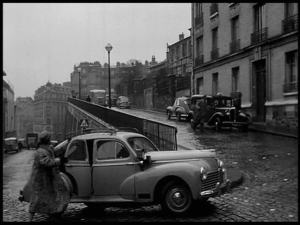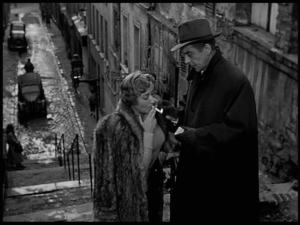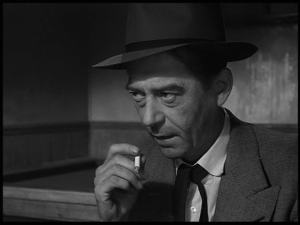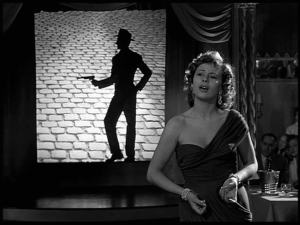Original French Title: Du Rififi Chez Les Hommes
Note: This article includes some moderate spoilers.
As a French-made noir by an American-born writer-director, Jules Dassin’s Rififi is an example of the film noir movement coming full circle. The genre had been kicked off, in part, by the arrival in Hollywood of directors fleeing wartime Germany, such as Fritz Lang, Otto Preminger and Billy Wilder. Just a few years later, though, the flow of talent had been reversed. American-born Jules Dassin was blacklisted in the anti-communist hysteria of the early fifties, and was forced first to Britain and then France in the search for work. Rififi, his first French film, folds a Gallic sensibility back into the American / German generic hybrid of noir: it anticipates the French obsession with gangster pictures that emerged a few years later in New Wave films such as Godard’s Bande à part / Band of Outsiders. The result is a fascinating blend, and a definitive example of a classic film emerging from enormously difficult personal circumstances.
It is perhaps best remembered, though, as the ultimate heist film, centering on a robbery orchestrated by Tony le Stéphanois (Jean Servais). Tony, a more bitter and hangdog version of the street-wise figures Bogart played in many American noir films, has just been released from prison. His friends Jo and Mario offer to include him in a smash and grab jewellery robbery they’re planning, and he initially declines. After finding out his wife has left him, however, he changes his mind and outlines a more ambitious plan to Jo and Mario: breaking into the store’s main safe. They recruit a safecracker, César (Dassin himself, billed as Perlo Vita), and go to work.
The central robbery scene is by far Rififi’s most famous scene, for both its length (at half an hour, it occupies roughly a quarter of the running time) and for unfolding without dialogue. This setpiece scene was what prompted Dassin to take the film: he hated the source novel, but sensed the possibilities of expanding an insignificant robbery in it. Certainly it is a very strong narrative hook, exploiting our natural interest in seeing how a really big con could be pulled off. Dassin builds on that inherent fascination to create a sequence of nail-biting tension. The robbery has become the template for set-piece heist sequences ever since, but rarely have the imitators matched Dassin’s single-mindedness. Despite its length, Dassin has the discipline not to worry about distractions such as cross-cutting to a parallel storyline or expository dialogue. The silence of the central characters, which is underlined by a lack of score, is vital to the effect of the sequence. Dassin uses this to exaggerate our awareness of the sounds that the characters make, pressing the point further by having all the characters freeze for even the most inconsequential accidental sound (such as a single note sounding when someone bumps a piano). When the thieves are finally cutting into the safe, the screeching sound of metal-on-metal becomes excruciating, creating an unbearable tension.
Yet Rififi is much more than just that one great sequence. It follows a classic three-act heist movie structure – preparation, robbery, and then the attempts to escape with the loot – and it is the third act that is most gripping. The opening sequences of the film are slightly tortuous, as Dassin establishes his cast of characters, but the work pays off in the final stretch of the movie. Having so carefully laid out his pieces, there’s no wasted exposition as he maps out the extended move and counter-move of the endgame. As is often the case in heist movies, there is just one small mistake that brings the plan undone. (This is the tacit message of many films in the genre: crime doesn’t pay… but it so easily could have.)
Dassin doesn’t dwell on the role that blind luck plays, however, instead emphasising the theme of loyalty and betrayal. This is an undertone that distinguishes Rififi from some of its contemporaries. Stanley Kubrick’s very similar The Killing (1956), for example, sees the plan likewise unravel due to the personal failings of some of the participants. Yet it is still the cosmic irony of that film’s conclusion that stays with you: Johnny Clay sees his millions blow away in the wind because of a dog and a poor lock on his suitcase. In Rififi, however, Dassin places more emphasis on the role of treachery. Tony’s participation in the robbery only comes about once he finds he has been betrayed by his wife, and as the plan unravels it is the loyalty of the individual team members that establishes their worth. None of this is unusual in itself, except for the sense of gravity Dassin, exiled to Europe because he had been named as a communist by those he counted as friends, brought to these scenes. The key moment of the movie sees Tony confront César about his betrayal of the others: César asks for forgiveness but accepts his punishment. Dassin has said that he wrote the scene thinking about the betrayals of the blacklist years, and his righteous outrage at his own treatment in this period gives the scene an added intensity. That Dassin, at the last minute, had to step in to play César, the traitor, only increases the scene’s poignancy.
 |
 |
It is also one of many moments that is enhanced by Dassin’s impeccable direction, with the camera tracking out slowly to heighten the drama of Tony’s vengeance. The camera is unusually mobile for such a cheaply made film, and Dassin makes heavy use of classic noir cinematography, with strong contrasts between shadow and light. This is occasionally self-conscious – as in the nightclub scene pictured at the foot of this article, which features stylised silhouettes in a self-referentially exaggerated noir style – but more often the style is employed for a moody naturalism. This is reinforced by the extensive use of real Parisian locations, which look fabulous and have considerable documentary interest in themselves. Rififi is a great example of the way low budget films can outmanoeuvre their higher budgeted competition through their ability to shoot more freely in real-world locations, gaining production value from the “sets” provided out on the real streets of the city.
The locations are not all that the film gained from being made in France, however. Dassin seems to have relished the chance to make a film free of the restrictions on content that would have applied in fifties Hollywood, which was still shaking off the Hays Code. The film’s depictions of violence, and especially its sexual overtones, are stronger than anything Dassin could have done in America. That’s part of what makes Rififi work so well: it has the genuine style and period feel of a fifties film, but in content resembles American films from a decade or more later. Dassin didn’t have to pull his punches, which means the anger underlying the film is that much more palpable.
In the end, the film itself is Dassin’s ultimate vindication. Fifty years on, its recognition as a classic proves not only that his creativity couldn’t be stifled, but also that Hollywood’s rejection of his talents was a self-destructive move.

